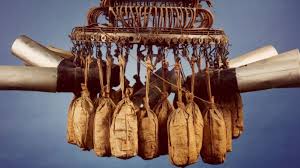


(File photo shows the balloons booms)
Ceramics and balloons were used as biological bombs on Chinese civilians and prisoners of war by a Japanese chemical warfare unit, according to a Chinese museum.
Many ceramic bombs and a three-meter-tall white balloon are on display at the Exhibition Hall of Evidences of Crime Committed by Unit 731 of the Japanese Imperial Army in Harbin, capital of northeast China's Heilongjiang Province.
Unit 731 produced about 2,000 ceramic bombs from 1937 to 1942, a staff member of the museum said on Monday, the 86th anniversary of the September 18 Incident.
On Sept. 18, 1931, the Japanese Imperial Army blew up a section of railway near the city of Shenyang, capital of Liaoning Province neighboring Heilongjiang. The incident started a large-scale Japanese invasion of China that would last 14 years.
Metal bombs required a lot of gunpowder to explode, and extremely high temperatures could easily destroy bacteria, so the Japanese began using ceramic bombs, which held anthrax and bubonic plague-carrier fleas, according to the museum staff member.
Ceramic bombs required very little gunpowder and when they exploded the biological agents were dispersed into the air, the staff member explained, adding that each plane could carry ten ceramic bombs containing around 5,000 fleas, which could kill a large number of domestic animals within one to two hours.
To help the diseases proliferate, the Japanese also used hot-air balloons to distribute plague-carrier fleas.
Infected clothing and supplies were also dropped to spread deadly pathogens.
"The evidence is new proof of the atrocities committed by the Japanese army," said Jin Chengmin, curator of the museum. "It serves as a warning for us to remember history and cherish peace."
Unit 731 was a top-secret biological and chemical warfare research base established in Harbin as the nerve center of Japanese biological warfare in China and Southeast Asia during WWII.
Civilians and prisoners of war from China, the Soviet Union, the Korean Peninsula and Mongolia all perished at the hands of Japanese scientists.
The retreating Japanese blew up the base when the Soviet Union army took Harbin in 1945.
 Fire brigade in Shanghai holds group wedding
Fire brigade in Shanghai holds group wedding Tourists enjoy ice sculptures in Datan Town, north China
Tourists enjoy ice sculptures in Datan Town, north China Sunset scenery of Dayan Pagoda in Xi'an
Sunset scenery of Dayan Pagoda in Xi'an Tourists have fun at scenic spot in Nanlong Town, NW China
Tourists have fun at scenic spot in Nanlong Town, NW China Harbin attracts tourists by making best use of ice in winter
Harbin attracts tourists by making best use of ice in winter In pics: FIS Alpine Ski Women's World Cup Slalom
In pics: FIS Alpine Ski Women's World Cup Slalom Black-necked cranes rest at reservoir in Lhunzhub County, Lhasa
Black-necked cranes rest at reservoir in Lhunzhub County, Lhasa China's FAST telescope will be available to foreign scientists in April
China's FAST telescope will be available to foreign scientists in April "She power" plays indispensable role in poverty alleviation
"She power" plays indispensable role in poverty alleviation Top 10 world news events of People's Daily in 2020
Top 10 world news events of People's Daily in 2020 Top 10 China news events of People's Daily in 2020
Top 10 China news events of People's Daily in 2020 Top 10 media buzzwords of 2020
Top 10 media buzzwords of 2020 Year-ender:10 major tourism stories of 2020
Year-ender:10 major tourism stories of 2020 No interference in Venezuelan issues
No interference in Venezuelan issues
 Biz prepares for trade spat
Biz prepares for trade spat
 Broadcasting Continent
Broadcasting Continent Australia wins Chinese CEOs as US loses
Australia wins Chinese CEOs as US loses